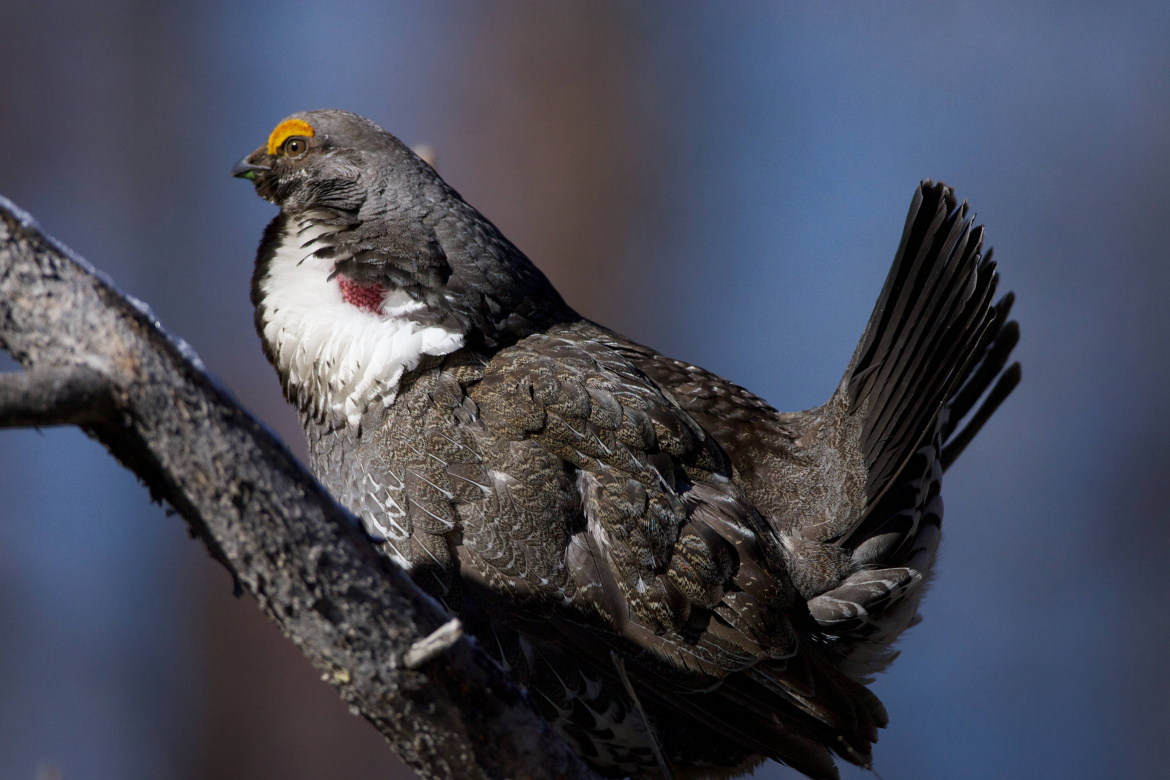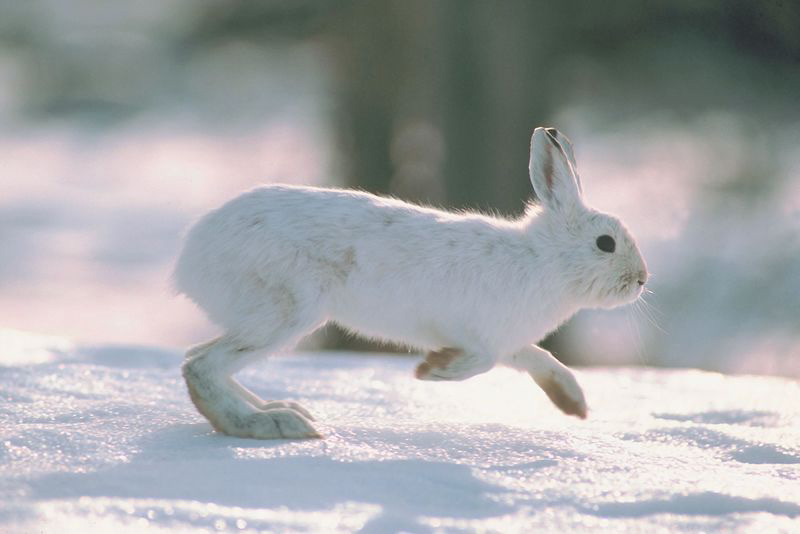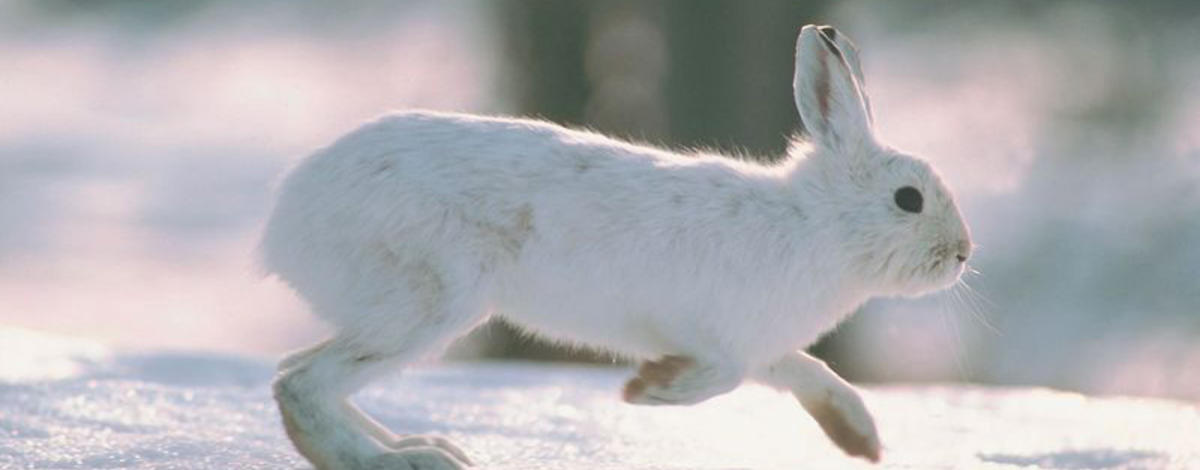Although most big game seasons are wrapped up for the year, there are open hunting seasons for small game throughout the winter months. North-central Idaho has some great woodland-agriculture interfaces that provide excellent habitat for small game animals, such as squirrel, rabbit, hare and grouse.
Here are five reasons why small game hunting might be the winter time activity for you:
Reason #1: Great for new or experienced hunters
Hunting small game, including squirrel, snowshoe hare, cottontail and forest grouse, presents excellent opportunities for new hunters to develop their skills and confidence without breaking the bank. The best part? Good hunting for all of these species can be found on public land.
It doesn’t take specialized or expensive gear to hunt them: the basic essentials are a .22 long rifle and/or any shotgun, and clothes and boots suitable for winter hiking. It can be done with or without a dog, and with a little bit of luck, good timing, and know-how, you can be successful.
Many of the skills you will learn while hunting small game — including observation skills, handling and shooting a firearm, field dressing and cooking the animals you harvest — will translate directly to big game hunting.
While hunting with a small-caliber rifle like a .22 (which has almost no recoil), it’s the perfect time to work on shooting mechanics in a real-world setting. Focus on building muscle memory for proper grip, trigger squeeze, and obtaining a sight picture from various shooting positions — all without the recoil of a larger, centerfire rifle.
If you are an experienced hunter and pursued big game during fall, don't store your hunting gear away quite yet. If you have not taken the opportunity to hunt small game, now is the time to extend your season and try something new!
Reason #2: Provide some fresh and nutritious game meat for your dinner table
Cleaning small game helps new hunters understand the basics of field dressing before they move to larger game. Once you get these small game species on the dinner table, there is a good chance they will want to keep hunting them. It's a chance to take pride in providing for your family while knowing where your food came from---the forest grocery. Fresh, nutritious quality lean meat is hard to beat.
Reason #3: Great way to continue to hone your shooting skills
New or experienced hunters can benefit from hunting small game. A small game animal, such as a rabbit or grouse, is a much smaller target than a deer or elk, so making clean shots can be challenging. You should always sight in your firearm and practice shooting before going into the field. Take your time, don't rush your shot, and be confident with your abilities before pulling the trigger. Make sure you take the time to identify your target and be certain that it is a safe shot to take. Is the animal in range? Is there anything in front of or beyond the target that could result in an unsafe shot?
This is also a great time to practice estimating target distances. While out in the woods and fields, take the opportunity to estimate how far you are from a rock or tree or clump of brush. Then, pace off the distance, or use a range finder to check your estimate. Hunters are often surprised at how poorly they estimate distances under various field conditions. You may do an excellent job in the woods, but require more practice over water or agricultural fields. Winter hunting allows you an opportunity to sharpen your shooting skills after other seasons are closed.
Reason #4: Fun to find animal sign in the snow
There is a lot to learn about animal activity from studying their sign in the snow. While you are chasing bunnies or grouse, bring along a pocket book to help identify tracks and scat that you find. You can learn where an animal is traveling to, what habitat it is using, what it has been eating, and times of peak movement. Animal tracking in the snow is an easy way to learn how to track animals and, with practice, can lead you to tracking on more solid ground.
Note the general size of the animal and their track pattern. Is it hopping, bounding, trotting, or walking? You can also study the sign and make a guess at how fresh it might be. Has it snowed recently? Is there fresh snow in the tracks? Kids love to investigate animal sign, so this is a great way to get them inspired in the outdoors.
Reason #5: Break the cabin fever
If you've been feeling a little cooped up lately, a trip out of the house to hunt small game might be just what you need. Break out the sled, skis, or snowshoes, bring along a Thermos of hot chocolate or soup, and bundle up for some fun, family, winter recreation. Make sure to bring extra warm clothing (gloves, hats, good boots), hand warmers, and waterproof layers to keep everyone comfortable in the snow. Breathe in the fresh cool air and get some exercise while making memories!
If you are going to hunt small game animals, it is good to learn a little more about them. Here is some common small game species information to get started:
The Forestland Trifecta
The list starts out with the small game forestland trifecta — red squirrel, snowshoe hare, and forest grouse — which can be hunted at the same time and in the same general type of habitat. Camouflage doesn’t hurt, but it isn’t necessary — earth-tone clothes will work fine. An orange hat and/or vest is highly encouraged as it makes you more visible to other hunters.
All three species can be hunted with either a shotgun or small caliber rifle, depending on the hunter’s preferences. Considering you may be doing a lot of walking at high elevation, keep weight in mind when choosing a firearm. For shotguns, a light 20-gauge loaded with No. 6-8 lead shot will work just fine.
- Season Dates: Aug. 30 - Jan. 31 (Northern Idaho)
- Bag limit: Four in the aggregate per day
- Equipment essentials: Small caliber hunting rifle or shotgun; hiking clothes and boots; upland hunting vest
- Licensing requirements: Small game or annual hunting license
Hunting tips – Forest grouse are among the mostly widely distributed upland birds in Idaho and commonly found on public lands, and they provide a hunting opportunity for nearly anyone. There are three species of forest grouse in Idaho, all of which are native to the state: the dusky (blue) grouse, the ruffed grouse, and the spruce grouse. No matter which you plan on pursuing, be ready for a workout. Forest grouse can be hunted with a dog, but you can also be successful without one.
Depending on your preference, you can either attempt to shoot flushing grouse on the wing with a shotgun, or stationary grouse in the trees with a rifle. Early in the season, forest grouse are generally in family groups, so filling your bag limit might be a little easier.
While each grouse species occupies a different niche, you can generally focus your efforts on two habitat elements: moisture and food sources along mountain streams and springs.

In Northern Idaho, ruffed grouse are the most common forest grouse. Good populations are also found in the mountains of north central Idaho. Riparian habitats and other moist mountain brush areas are commonly used by these birds, and hunters should pay particular attention to new-growth aspen draws.

Dusky (blue) grouse are found at lower elevations early in the season, and move up throughout the year. Dusky grouse favor high-elevation sagebrush and mountain shrub areas for nesting, springs and stream banks for rearing young, and rely heavily on Douglas fir for winter food and cover. Early in the season, hunters should focus their efforts on the edge habitat between mature forest stands and grasslands. Keep an eye out for food sources like snowberry shrubs, serviceberry, and rose hip.

Spruce grouse are found in dense, high-elevation conifer forests. If, while you are trudging around the dense spruce stands where these birds are commonly found, you can find a stream bed lined with dwarf huckleberry, you’ve found a great place to start searching for them.

- Season dates: Aug. 30 - March 31
- Bag limit: Eight per day
- Equipment essentials: Small caliber hunting rifle or shotgun; (warm) hiking clothes and boots
- Licensing requirements: Small game or annual hunting license
Hunting tips – Snowshoe hares are another native game species that are found primarily at higher elevations, forested regions of northern, central and eastern Idaho. They are active during the night, and the best time to hunt them is within a couple hours of sunrise and sunset. Snowshoe hares prefer dense coniferous or mixed forests with lots of understory cover, and are especially fond of stands of young conifer and aspen trees.
Hunting gets better as the weather cools and after the first snow of the year, when hunters have an easier time locating and following a snowshoe hare’s distinct tracks. Many snowshoe hare hunters use dogs, such as beagles, to flush them.
Snowshoe hares are also known as varying hares, because their coats change colors to blend in with the colors of the seasons — white in the winter, and grayish-brown in the summer. During the fall and spring, when they are in the midst of this color change, snowshoe hares have a tougher time blending with their surroundings.
For hunters without dogs, this is the best time to stalk the forest with a small caliber, scoped rifle, searching the cover for stationary hares. While not necessary, consider bringing a pair of binoculars along.
Make no mistake — this makes for challenging hunting, and you’re probably not going to harvest a limit of snowshoe hares using this approach. But learning to move quietly through the forest and honing your observational skills will set you up for success when you’re ready to move on to larger game species.

- Season dates: Aug. 30 - March 31
- Bag limit: Eight per day
- Equipment essentials: Small caliber hunting rifle, air rifle or shotgun; hiking clothes and boots
- License requirements: Small game or annual hunting license
Hunting tips – There are a number of squirrel species in Idaho, but only the red squirrel is classified as a game animal. Red squirrels are native to Idaho and found all over the state’s forests. They are typically active throughout the day, as they work to stockpile food to get ready for the winter. This is the best time to get out into Idaho’s forests and search for your quarry.
You shouldn’t have too much trouble finding them if you use your ears: red squirrels are notoriously vocal. They are also solitary and very territorial, with ranges that stretch between two and five acres. You’re likely going to have to do some hiking to fill your bag limit, but there are worse ways to get exercise than hiking around Idaho’s picturesque forests.
Red squirrels eat seeds, conifer cones, nuts and fruits, and will occasionally feed on invertebrates and small vertebrates. They don’t hibernate during the winter. Instead, during the early fall, they cut cones from from conifer trees and stockpile them in storage areas called “middens.” If you can find a midden, which are typically near the center of a squirrel’s territory, you are likely to find the squirrel that built it.
For more information on small game hunting in the Clearwater region, contact the regional office at (208) 799-5010.

